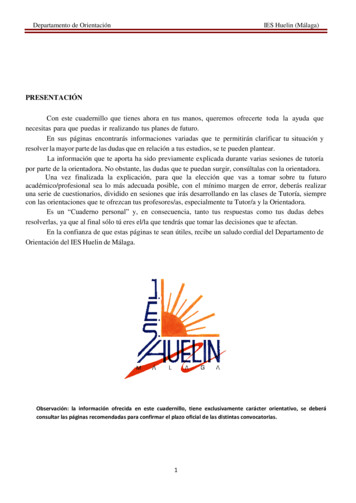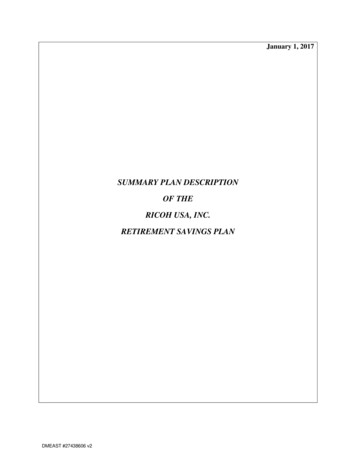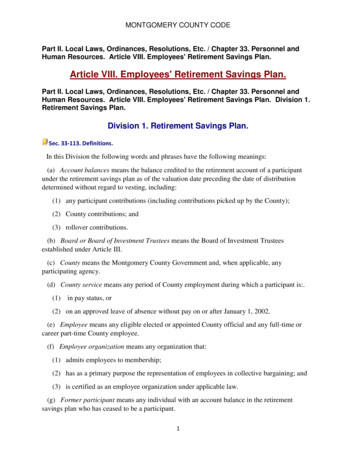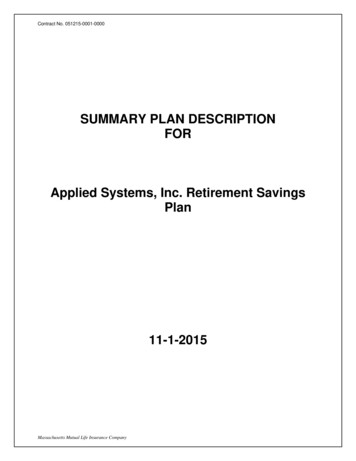
Transcription
IES HOLDINGS, INC. RETIREMENT SAVINGS PLANSUMMARY PLAN DESCRIPTION
TABLE OF CONTENTSINTRODUCTION TO YOUR PLANWhat kind of Plan is this? . 1What information does this Summary provide? . 1ARTICLE IPARTICIPATION IN THE PLANHow do I participate in the Plan? . 1What service is counted for purposes of Plan eligibility? . 2What happens if I'm a participant, terminate employment and then I'm rehired? . 2ARTICLE IIEMPLOYEE CONTRIBUTIONSWhat are elective deferrals and how do I contribute them to the Plan? . 2What are rollover contributions? . 3ARTICLE IIIEMPLOYER CONTRIBUTIONSWhat is the Employer matching contribution and how is it allocated? . 3What is the Employer nonelective contribution and how is it allocated? . 3What is the prevailing wage contribution?. 4How is my service determined for allocation purposes? . 4What are forfeitures and how are they allocated? . 4ARTICLE IVCOMPENSATION AND ACCOUNT BALANCEWhat compensation is used to determine my Plan benefits? . 5Is there a limit on the amount of compensation which can be considered? . 5Is there a limit on how much can be contributed to my account each year? . 5How is the money in the Plan invested? . 5How may I provide investment direction? . 6Will Plan expenses be deducted from my account balance? . 6ARTICLE VVESTINGWhat is my vested interest in my account? . 7How is my service determined for vesting purposes? . 7What service is counted for vesting purposes? . 8What happens to my non-vested account balance if I'm rehired? . 8What happens if the Plan becomes a "top-heavy plan"? . 8ARTICLE VIDISTRIBUTIONS PRIOR TO TERMINATION OF EMPLOYMENTCan I withdraw money from my account while working? . 8Can I withdraw money from my account in the event of financial hardship? . 9ARTICLE VIIDISTRIBUTIONS UPON TERMINATION OF EMPLOYMENTWhen can I get money out of the Plan? . 9What is Normal Retirement Age and what is the significance of reaching Normal Retirement Age? . 10i
What happens if I terminate employment due to disability? . 10In what method and form will my benefits be paid to me? . 10ARTICLE VIIIDISTRIBUTIONS UPON DEATHWhat happens if I die while working for the Employer? . 11Who is the beneficiary of my death benefit? . 11How will the death benefit be paid to my beneficiary? . 12When must the last payment be made to my beneficiary (required minimum distributions)? . 12What happens if I terminate employment, commence payments and then die before receiving all of my benefits? . 12ARTICLE IXTAX TREATMENT OF DISTRIBUTIONSWhat are my tax consequences when I receive a distribution from the Plan?. 12Can I elect a rollover to reduce or defer tax on my distribution? . 12ARTICLE XLOANSIs it possible to borrow money from the Plan? . 13ARTICLE XIPROTECTED BENEFITS AND CLAIMS PROCEDURESAre my benefits protected? . 13Are there any exceptions to the general rule? . 13Can the Employer amend the Plan? . 14What happens if the Plan is discontinued or terminated? . 14How do I submit a claim for Plan benefits? . 14What is the Plan's procedure for making a claim that an error was made in processing my Plan account? . 14What if my benefits are denied? . 14What is the claims review procedure? . 15What are my rights as a Plan participant? . 16What can I do if I have questions or my rights are violated? . 16ARTICLE XIIGENERAL INFORMATION ABOUT THE PLANPlan Name . 17Employer Information . 17Plan Number . 17Plan Effective Dates . 17Other Plan Information . 17Employer Information . 17Plan Administrator Information . 17Plan Administrator Information . 18Plan Trustee Information and Plan Funding Medium . 18ii
IES HOLDINGS, INC. RETIREMENT SAVINGS PLANSUMMARY PLAN DESCRIPTIONINTRODUCTION TO YOUR PLANWhat kind of Plan is this?IES Holdings, Inc. Retirement Savings Plan ("Plan") has been adopted to provide you with the opportunity to save for retirement on a taxadvantaged basis. This Plan is a type of qualified retirement plan commonly referred to as a 401(k) Plan. As a participant under the Plan,you may elect to contribute a portion of your compensation to the Plan.What information does this Summary provide?This Summary Plan Description ("SPD") contains information regarding when you may become eligible to participate in the Plan, yourPlan benefits, your distribution options, and many other features of the Plan. You should take the time to read this SPD to get a betterunderstanding of your rights and obligations under the Plan.In this SPD, the Employer has addressed the most common questions you may have regarding the Plan. If this SPD does not answer all ofyour questions, please contact the Plan Administrator or other plan representative. The Plan Administrator is responsible for responding toquestions and making determinations related to the administration, interpretation, and application of the Plan. The name of the PlanAdministrator can be found at the end of this SPD in the Article entitled "General Information about the Plan."This SPD describes the Plan's benefits and obligations as contained in the legal Plan document, which governs the operation of the Plan.The Plan document is written in much more technical and precise language and is designed to comply with applicable legal requirements. Ifthe non-technical language in this SPD and the technical, legal language of the Plan document conflict, the Plan document always governs.If you wish to receive a copy of the legal Plan document, please contact the Plan Administrator.The Plan and your rights under the Plan are subject to federal laws, such as the Employee Retirement Income Security Act (ERISA) and theInternal Revenue Code, as well as some state laws. The provisions of the Plan are subject to revision due to a change in laws or due topronouncements by the Internal Revenue Service (IRS) or Department of Labor (DOL). The Employer may also amend or terminate thisPlan. If the provisions of the Plan that are described in this SPD change, the Employer will notify you.ARTICLE IPARTICIPATION IN THE PLANHow do I participate in the Plan?Provided you are not an Excluded Employee, you may begin participating under the Plan once you have satisfied the eligibilityrequirements and reached your Entry Date. The following describes Excluded Employees, if any, the eligibility requirements and EntryDates that apply. You should contact the Plan Administrator if you have questions about the timing of your Plan participation.All ContributionsExcluded Employees. If you are a member of a class of employees identified below, you are an Excluded Employee and you are notentitled to participate in the Plan. The Excluded Employees are: union employees whose employment is governed by a collective bargaining agreement under which retirement benefits werethe subject of good faith bargaining certain nonresident aliens who have no earned income from sources within the United States residents of Puerto Rico or any employee performing services in Puerto Rico leased employees reclassified employees (an employee who was previously not treated as an employee of the Employer but you arereclassified as being an employee)Eligibility Conditions. You will be eligible to participate in the Plan when you have attained age 18. However, you will actually enterthe Plan once you reach the Entry Date as described below.Additional eligibility condition provisionsCompletion of thirty (30) days of service is required for all contributions, except as provided for in a merger or acquisition agreement.See the Plan Administrator for additional information if you are not sure if this affects you.1
Entry Date. Your Entry Date will be the first day of the month coinciding with or next following the date you satisfy the eligibilityrequirements.Prevailing Wage ContributionIf you are working under a prevailing wage contract, then for purposes of receiving any prevailing wage contribution made to the Plan, youare eligible to participate on the date your employment is covered under the contract and will enter the Plan on that date, unless theprevailing wage contract provides otherwise.Additional Entry Date provisionsA special Entry Date may apply if provided for in a merger or acquisition agreement. See the Plan Administrator for additional informationif you are not sure if this affects you.What service is counted for purposes of Plan eligibility?Service with the Employer. In determining whether you satisfy the minimum service requirements to participate under the Plan, allservice you perform for the Employer will be counted.Military Service. If you are a veteran and are reemployed under the Uniformed Services Employment and Reemployment Rights Act of1994, your qualified military service may be considered service with the Employer. If you may be affected by this law, ask the PlanAdministrator for further details.What happens if I'm a participant, terminate employment and then I'm rehired?If you are no longer a participant because of a termination of employment, and you are rehired, then you will be able to participate in thePlan on the date on which you are rehired if you are otherwise eligible to participate in the Plan.ARTICLE IIEMPLOYEE CONTRIBUTIONSWhat are elective deferrals and how do I contribute them to the Plan?Elective Deferrals. As a participant under the Plan, you may elect to reduce your compensation by a specific percentage amount and havethat amount contributed to the Plan on a pre-tax basis as an elective deferral. Your taxable income is reduced by the deferral contribution soyou pay less in federal income taxes (however, the amount you defer is still counted as compensation for purposes of Social Securitytaxes). Later, when the Plan distributes the deferrals and earnings, you will pay the taxes on those deferrals and the earnings. Therefore,federal income taxes on the deferral contributions and on the earnings are only postponed. Eventually, you will have to pay taxes on theseamounts.Deferral procedure. The amount you elect to defer will be deducted from your pay in accordance with a procedure established by the PlanAdministrator. If you wish to defer, the procedure will require that you enter into a salary reduction agreement. You may elect to defer aportion of your compensation payable on or after your Entry Date. Such election will become effective as soon as administratively feasibleafter it is received by the Plan Administrator. Your election will remain in effect until you modify or terminate it.Deferral modifications. You may revoke or make modifications to your salary deferral election in accordance with procedures that theEmployer provides. See the Plan Administrator for further information.Annual dollar limit. Your total deferrals in any taxable year may not exceed a dollar limit which is set by law. The limit for 2015 is 18,000. After 2015, the dollar limit may increase for cost-of-living adjustments.Deferrals limited by nondiscrimination testing. In addition to the annual dollar limit just described, the law requires testing of thedeferrals to ensure that deferrals by HCEs do not exceed certain limits. If you are a highly compensated employee (generally more than 5%owners and certain family members (regardless of how much they earn), or individuals receiving wages in excess of certain amountsestablished by law), a distribution of amounts attributable to your elective deferrals or certain excess contributions may be required tocomply with the law. The Plan Administrator will notify you if and when a distribution of deferrals is required.Catch-up contributions. If you are at least age 50 or will attain age 50 before the end of a calendar year, then you may elect to deferadditional amounts in whole percentage amounts (called "catch-up contributions") to the plan for that year. The additional amounts may bedeferred regardless of any other limitations on the amount that you may defer to the plan. The maximum "catch-up contribution" that youcan make in 2015 is 6,000. After 2015, the maximum may increase for cost-of-living adjustments. Any "catch-up contributions" that youmake will not be taken into account in determining any Employer matching contribution made to the Plan.You should be aware that each separately stated annual dollar limit on the amount you may defer (the annual deferral limit and the"catch-up contribution" limit) is a separate aggregate limit that applies to all such similar elective deferral amounts and "catch-upcontributions" you may make under this Plan and any other cash or deferred arrangements (including tax-sheltered 403(b) annuity2
contracts, simplified employee pensions or other 401(k) plans) in which you may be participating. Generally, if an annual dollar limit isexceeded, then the excess must be returned to you in order to avoid adverse tax consequences. For this reason, it is desirable to request inwriting that any such excess elective deferral amounts be returned to you.If you are in more than one plan, you must decide which plan or arrangement you would like to return the excess. If you decide that theexcess should be distributed from this Plan, you must communicate this in writing to the Plan Administrator no later than the March 1stfollowing the close of the calendar year in which such excess deferrals were made. However, if the entire dollar limit is exceeded in thisPlan or any other plan the Employer maintains, then you will be deemed to have notified the Plan Administrator of the excess. The PlanAdministrator will then return the excess deferral and any earnings to you by April 15th.What are rollover contributions?Rollover contributions. At the discretion of the Plan Administrator, if you are an eligible employee, you may be permitted to deposit intothe Plan distributions you have received from other plans and certain IRAs. Such a deposit is called a "rollover" and may result in taxsavings to you. You may ask the Plan Administrator or Trustee of the other plan or IRA to directly transfer (a "direct rollover") to this Planall or a portion of any amount that you are entitled to receive as a distribution from such plan. Alternatively, you may elect to deposit anyamount eligible to be rolled over within 60 days of your receipt of the distribution. You should consult qualified counsel to determine if arollover is in your best interest.Rollover account. Your rollover will be accounted for in a "rollover account." You will always be 100% vested in your "rollover account"(see the Article in this SPD entitled "Vesting"). This means that you will always be entitled to all amounts in your rollover account.Rollover contributions will be affected by any investment gains or losses.Withdrawal of rollover contributions. You may withdraw the amounts in your "rollover account" at any time. You should see theArticles in this SPD entitled "Distributions Prior to Termination of Employment," "Distributions upon Termination of Employment," and"Distributions upon Death" for an explanation of how benefits (including your "rollover account") are paid from the Plan.ARTICLE IIIEMPLOYER CONTRIBUTIONSIn addition to any deferrals you elect to make, the Employer will make additional contributions to the Plan. This Article describesEmployer contributions that will be made to the Plan and how your share of the contributions is determined.What is the Employer matching contribution and how is it allocated?Matching Contribution. The Employer may make a discretionary matching contribution equal to a uniform percentage or dollar amountof your elective deferrals. Each year, the Employer will determine the formula for the discretionary matching contribution.The Plan will not match any catch-up deferrals.If any related employers (related to the employer by common ownership) elect to participate in the Plan, the employees of those relatedemployers may become participants. If this occurs, the related employers' matching contributions to the Plan will be made based on thesame formula as applies to the employer. Any matching contribution made by a related employer will be allocated among all employeesparticipating in the plan, regardless of which employer they work for.Allocation conditions. In order to share in the matching contribution for a Plan Year, you must satisfy the following conditions:1,000 Hours of Service in a Plan Year and Last day of the Plan Year as to the True-up Match.Waiver of allocation conditionsYou will share in the matching contribution for the year you terminate employment regardless of the amount of service you completeduring the Plan Year if you terminate on or following your death, disability, or attainment of Normal Retirement Age.What is the Employer nonelective contribution and how is it allocated?Nonelective contribution. Each year, the Employer may make a discretionary nonelective contribution to the Plan. Your share of anycontribution is determined below.If any related employers (related to the employer by common ownership) elect to participate in the Plan, the employees of those relatedemployers may become participants. If this occurs, the related employers' nonelective contributions to the Plan will be made based on thesame formula as applies to the employer.Allocation conditions. In order to share in the nonelective contribution you must satisfy the following conditions: If you are employed on the last day of the Plan Year, you will share if you completed at least 1,000 Hours of Service during thePlan Year.3
Waiver of allocation conditionsYou will share in the nonelective contribution for the year you terminate employment regardless of the amount of service you completeduring the Plan Year if you terminate on or following your death, disability or attainment of Normal Retirement Age.Your share of the contribution. The nonelective contribution will be "allocated" or divided among participants eligible to share in thecontribution for the Plan Year.Your share of the nonelective contribution is determined by the following fraction:Nonelective ContributionXYour CompensationTotal Compensation of AllParticipants Eligible toShareFor example: Suppose the nonelective contribution for the Plan Year is 20,000. Employee A's compensation for the Plan Year is 25,000. The total compensation of all participants eligible to share, including Employee A, is 250,000. Employee A's share will be: 20,000X 25,000 250,000or 2,000If any related employers (related to the employer by common ownership) elect to participate in the Plan, the employees of those relatedemployers may become participants. If this occurs, the related employers' nonelective contributions to the Plan will be allocated based onthe same method as applies to the employer. Any nonelective contribution made by a related employer will be allocated among allemployees participating in the plan, regardless of which employer they work for.What is the prevailing wage contribution?Prevailing wage contribution. If the work you perform for the Employer is subject to prevailing wage laws, then the Employer will makecontributions to this Plan to help satisfy the fringe benefit requirements of the law. You will receive this contribution based on the workyou perform during a Plan Year that is subject to the law. This contribution is 100% vested (see the Article in this SPD entitled "Vesting").The contribution the Employer makes according to prevailing wage laws will be allocated to you each Plan Year and will offset anyadditional employer contributions the Employer may make on your behalf for the Plan Year.How is my service determined for allocation purposes?Hour of Service. The Plan does not credit you with your actual Hours of Service. Instead the Plan uses the monthly "equivalency" method.Under the equivalency method stated above, you will be credited with the stated number of Hours of Service for the period from thefollowing list provided you complete at least one Hour of Service during the specified period:10 Hours of Service for each day - (daily method)45 Hours of Service for each week - (weekly method)95 Hours of Service for each semi-monthly payroll period - (semi-monthly payroll period method)190 Hours of Service for each month - (monthly method)What are forfeitures and how are they allocated?Definition of forfeitures. In order to reward employees who remain employed with the Employer for a long period of time, the law permitsa "vesting schedule" to be applied to certain contributions that the Employer makes to the Plan. This means that you will not be entitled to("vested" in) all of the contributions until you have been employed with the Employer for a specified period of time (see the Article in thisSPD entitled "Vesting"). If a participant terminates employment before being fully vested, then the non-vested portion of the terminatedparticipant's account balance remains in the Plan and is called a forfeiture. Forfeitures may be used by the Plan for several purposes.Allocation of forfeitures. Forfeitures will be allocated as follows: Forfeitures may be used to pay plan expenses, used to reduce any nonelective contribution or used to reduce any matchingcontribution.4
ARTICLE IVCOMPENSATION AND ACCOUNT BALANCEWhat compensation is used to determine my Plan benefits?All ContributionsDefinition of compensation. Compensation is defined as your total compensation that is subject to income tax withholding and paid to youby the Employer. The following describes the adjustments to compensation that apply for the contributions noted above.Adjustments to compensation. The following adjustments to compensation will be made: elective deferrals to this Plan and to any other plan or arrangement (such as a cafeteria plan) will be included. compensation paid while not a Participant in the component of the Plan for which compensation is being used will be excluded. compensation paid after you terminate is generally excluded for Plan purposes. However, the following amounts will be includedin compensation even though they are paid after you terminate employment, provided these amounts would otherwise have beenconsidered compensation as described above and provided they are paid within 2 1/2 months after you terminate employment, or iflater, the last day of the Plan Year in which you terminate employment: compensation paid for services performed during your regular working hours, or for services outside your regular workinghours (such as overtime or shift differential), or other similar payments that would have been made to you had you continuedemployment. compens
What kind of Plan is this? IES Holdings, Inc. Retirement Savings Plan ("Plan") has been adopted to provide you with the opportunity to save for retirement on a tax-advantaged basis. This Plan is a type of qualified retirement plan commonly referred to as a 401(k) Plan. As a participant under the Plan,










